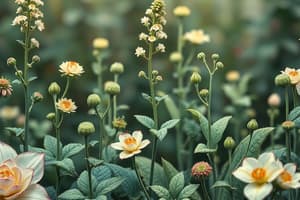Podcast
Questions and Answers
What is the primary use of Petitgrain essential oil?
What is the primary use of Petitgrain essential oil?
- Relaxing muscle tension
- Stimulating digestive issues
- Enhancing emotional clarity
- Calming and balancing skincare (correct)
Bitter orange essential oil is sweeter than sweet orange essential oil.
Bitter orange essential oil is sweeter than sweet orange essential oil.
False (B)
What are two emotional issues that Petitgrain essential oil can help alleviate?
What are two emotional issues that Petitgrain essential oil can help alleviate?
Insomnia and stress
Bitter orange essential oil is extracted from the __________ of the bitter orange tree.
Bitter orange essential oil is extracted from the __________ of the bitter orange tree.
Match the following plants with their primary uses:
Match the following plants with their primary uses:
What is another common name for 'Chanca Piedra'?
What is another common name for 'Chanca Piedra'?
Environmental factors do not affect plant metabolic processes.
Environmental factors do not affect plant metabolic processes.
Name one effect of low iron levels in plants.
Name one effect of low iron levels in plants.
Plants have developed biochemical protective mechanisms against elevated doses of ______.
Plants have developed biochemical protective mechanisms against elevated doses of ______.
Match the following environmental factors with their impacts on plants:
Match the following environmental factors with their impacts on plants:
Which of the following is a secondary metabolite production trigger?
Which of the following is a secondary metabolite production trigger?
UV-B radiation can enhance gene transcription in plants.
UV-B radiation can enhance gene transcription in plants.
Why do plants evolve mechanisms for optimizing light absorption?
Why do plants evolve mechanisms for optimizing light absorption?
What is one advantage of cultivating medicinal plants?
What is one advantage of cultivating medicinal plants?
The cultivation of medicinal plants requires unskilled labor.
The cultivation of medicinal plants requires unskilled labor.
Name two medicinal plants mentioned that can illustrate the cultivation of rhizomes.
Name two medicinal plants mentioned that can illustrate the cultivation of rhizomes.
Cultivation of __________ plants can lead to industrialisation.
Cultivation of __________ plants can lead to industrialisation.
Match the following terms with their definitions:
Match the following terms with their definitions:
Which of the following factors can contribute to losses in cultivated medicinal plants?
Which of the following factors can contribute to losses in cultivated medicinal plants?
Inter/Intra Species Variation does not affect the quality of medicinal plants.
Inter/Intra Species Variation does not affect the quality of medicinal plants.
What is the role of skilled labor in the preservation of medicinal plant quality?
What is the role of skilled labor in the preservation of medicinal plant quality?
Which of the following is NOT a disadvantage of the sexual method of plant propagation?
Which of the following is NOT a disadvantage of the sexual method of plant propagation?
Scorpion venom is used as a treatment for potential benefits such as cancer and rheumatoid arthritis.
Scorpion venom is used as a treatment for potential benefits such as cancer and rheumatoid arthritis.
What are the two main methods of plant propagation mentioned?
What are the two main methods of plant propagation mentioned?
The __________ method of plant propagation uses seeds to raise plants known as seedlings.
The __________ method of plant propagation uses seeds to raise plants known as seedlings.
Match the following medicinal substances with their sources:
Match the following medicinal substances with their sources:
What is the primary advantage of using seedlings in the sexual method of propagation?
What is the primary advantage of using seedlings in the sexual method of propagation?
Poisonous and hallucinogenic plants can have medicinal effects.
Poisonous and hallucinogenic plants can have medicinal effects.
What must be ensured for successful seed propagation?
What must be ensured for successful seed propagation?
What is the diameter of fine clay particles?
What is the diameter of fine clay particles?
Chemical fertilizers provide the same nutrients as manures in equal quantities.
Chemical fertilizers provide the same nutrients as manures in equal quantities.
Name one type of biofertilizer mentioned in the content.
Name one type of biofertilizer mentioned in the content.
Soil fertility can be maintained by addition of animal manures and __________.
Soil fertility can be maintained by addition of animal manures and __________.
Match the types of soil with their corresponding particle sizes:
Match the types of soil with their corresponding particle sizes:
Which of the following is a primary nutrient for plants?
Which of the following is a primary nutrient for plants?
Clay soil has poor nutrient retention and leaches nutrients easily.
Clay soil has poor nutrient retention and leaches nutrients easily.
What is one disadvantage of using chemical fertilizers according to the content?
What is one disadvantage of using chemical fertilizers according to the content?
Flashcards are hidden until you start studying
Study Notes
Cultivation of Medicinal Plants
- Cultivating rhizomes requires proper fertilization and irrigation.
- Systematic cultivation increases volatile oil content and other constituents in medicinal plants.
- Examples of rhizomes are ginger, turmeric, and licorice
- Keeping plants free from weeds avoids contamination of crude drugs.
- Cultivating medicinal plants ensures a higher yield and therapeutic quality of crude drugs.
- Quality control requires skilled and experienced personnel.
- Examples of quality control include collecting latex from poppy capsules and oleo-resins from Pinus species, preserving the green color of senna leaves, and minimizing the deterioration of cardiac glycosides in fresh digitalis leaves.
- Cultivation ensures a regular supply of crude drugs, reducing shortages.
- Cultivation leads to industrialization.
- Examples of industrialization include the cultivation of coffee and cocoa in Kerala, the cultivation of cinchona in West Bengal, and the Opium factory in Gazibad.
- Cultivation allows for the application of modern technological aspects like mutation, polyploidy, and hybridization.
Disadvantages of Cultivation
- High cost compared to collecting from the wild.
- Loss due to ecological imbalances such as storms, earthquakes, floods, and droughts.
Inter/Intra Species Variation in Plants
- Variation occurs in both primary and secondary metabolites.
- Variation in constituents creates difficulties in standardization.
- Variations are genetically controlled and influenced by the country of origin for a particular species.
- Examples are Phyllanthus amarus and P. niruri, which are morphologically similar despite growing in different environments.
Environmental Factors Affecting Plant Quality
- Environmental factors affect plant metabolic processes, development, growth rates, and the partitioning of assimilates into vital metabolites.
- Environmental factors can trigger qualitative changes in secondary metabolite production.
- Climate is a significant abiotic factor affecting biosynthetic levels and quality of secondary metabolites.
- Soil nutrients affect plant quality.
- Proanthocyanidin levels increase under nutritional stress, such as limited phosphate availability.
- Low iron levels stimulate the biosynthesis of phenolic compounds.
Environmental Factors - Sunlight
- Plants have evolved mechanisms to protect against damaging UV radiation and extreme light intensities.
- Plants optimize the absorption of useful light spectra.
- UV-B radiation can impair gene transcription and translation, as well as photosynthesis.
- Light signals integrate into the plant's signaling network system to shape growth and development.
Other Factors Affecting Plant Quality
- Time of harvesting (season, time of day), soil type, post-harvesting factors (storage, transport, light, humidity, insects, microorganisms), contaminants (animal excreta, soil, insects), pesticides and other toxic metals.
Examples of Medicinal Plants
- Sida cordifolia
- Syzygium cumini
Animal Sources of Medicines
- Honey: Examples include:
- Honey used in traditional medicine
- Scorpion Venom: Used for cancer treatment and rheumatoid arthritis.
- Gelatin
- Surgical dressings, flavorings, suspending agents, disintegrants, filtering and supporting media, poisonous and hallucinogenic plants, raw materials for production of oral contraceptives, allergens, herbicides, and insecticides.
Method of Propagation
- Plant propagation deals with the production of new plants using various starter materials like organs or tissues.
- Two methods of propagation are used for medicinal plants: sexual and asexual.
Sexual Method (Seed Propagation)
-
Advantages:
- Seedlings are long-lived (in perennial drugs) and bear more heavily.
- Seedlings are sturdier.
- Seedlings are comparatively cheaper and easier to raise.
- Seed propagation allows for the production of superior seedlings (like orange, papaya).
- It is the only method of choice for plants where other vegetative methods cannot be used.
-
Limitations:
- Seedling trees are not uniform in growth and yielding capacity.
- They require more time to bear than grafted plants.
- The cost of harvesting, spraying pesticides, etc., is higher than for grafted trees.
- It is impossible to modify the influence of rootstocks on scion, as in the case of vegetatively propagated trees.
Seed Propagation
- Seeds must be of good quality.
- Clay Characteristics:
- Fine particles.
- Provides cohesive and adhesive properties.
- Holds plant nutrients, preventing leaching.
Types of Soil
- Fine clay: Less than 0.002 mm in diameter
- Coarse clay/silt: 0.002-0.02 mm
- Fine sand: 0.02-0.2 mm
- Coarse sand: 0.2-2.00 mm
Types of Soil Based on Clay Percentage
- Sandy soils: Less than 15% clay
- Loamy soils: 15-30% clay
- Clay soils: Greater than 30% clay
Soil Fertility
- Soil fertility can be maintained by:
- Adding animal manure
- Introducing nitrogen-fixing bacteria.
- Applying chemical fertilizers
- Chemical fertilizers provide a faster and more reliable method.
Fertilizers and Manures
- Plants need food for their growth and development:
- Carbon dioxide
- Sun-rays
- Water
- Mineral matter from the soil
- Plants require specific nutrient elements:
- Primary nutrients: Nitrogen, Phosphorus, Potassium.
- Secondary nutrients: Magnesium, Calcium, Sulfur.
- Trace elements/micronutrients: Copper, Manganese, Iron, Boron, Molybdenum, Zinc, Carbon, Hydrogen, Oxygen, Chlorine (provided by water and air).
Chemical Fertilizers
- Chemical fertilizers supplement the plant's needs for specific nutrients.
- Each element plays a specific role in plant growth and development, with specific symptoms associated with its deficiency.
Manures
- Organic fertilizers include:
- Farm yard manure (FYM/compost)
- Castor seed cake
- Poultry manures
- Neem and karanji seed cakes
- Vermin compost
- Oil cake and compost provide nitrogen, phosphates, and potash.
- Other organic fertilizers: bone meal, fish meal, biogas slurry, blood meal, and press mud.
Biofertilizers
- Biofertilizers are used when fertilizers and manures are inadequate, costly, or have undesirable side effects.
- Biofertilizers provide a more sustainable and environmentally friendly alternative.
Studying That Suits You
Use AI to generate personalized quizzes and flashcards to suit your learning preferences.




